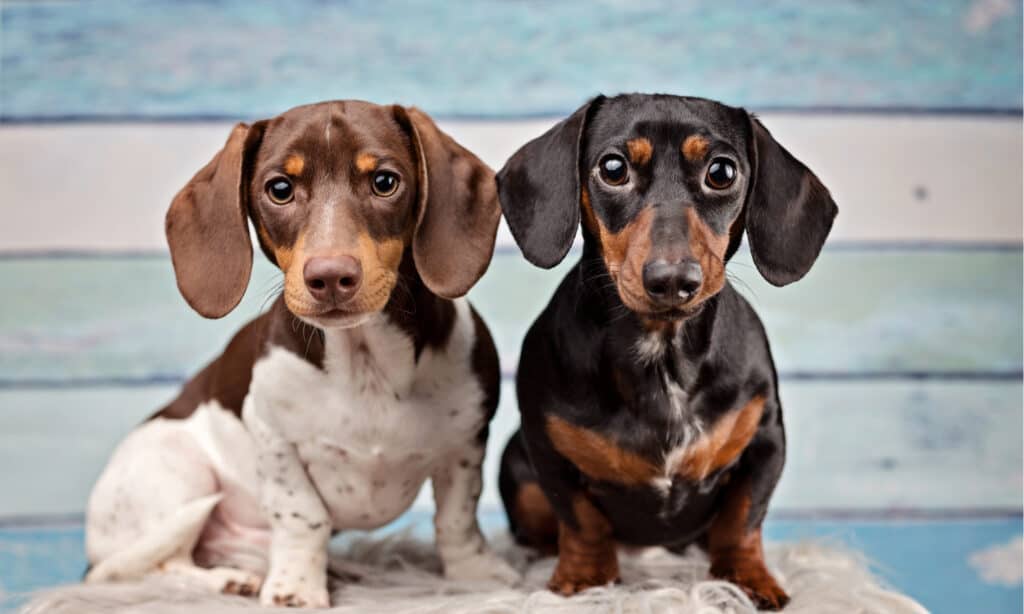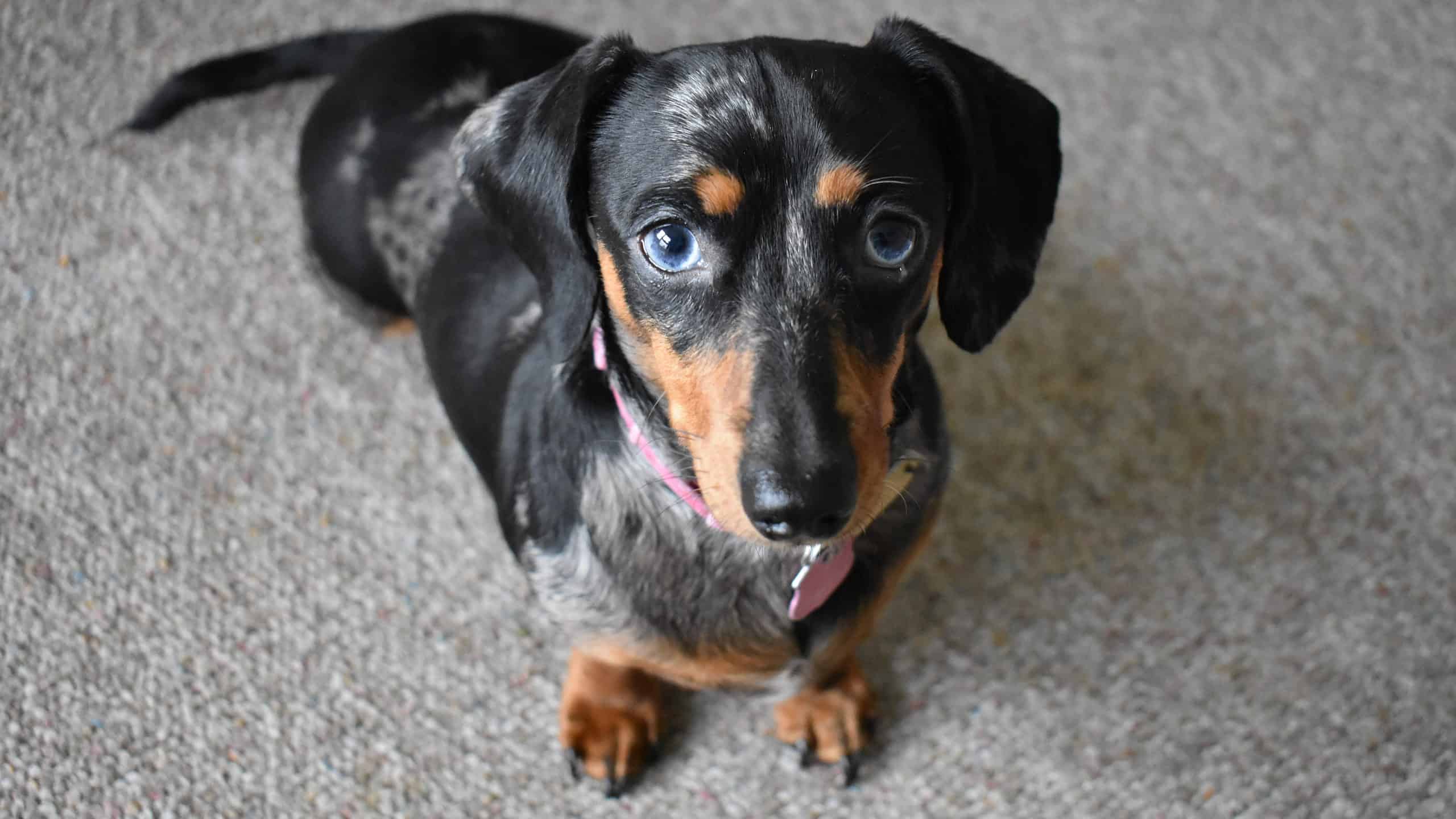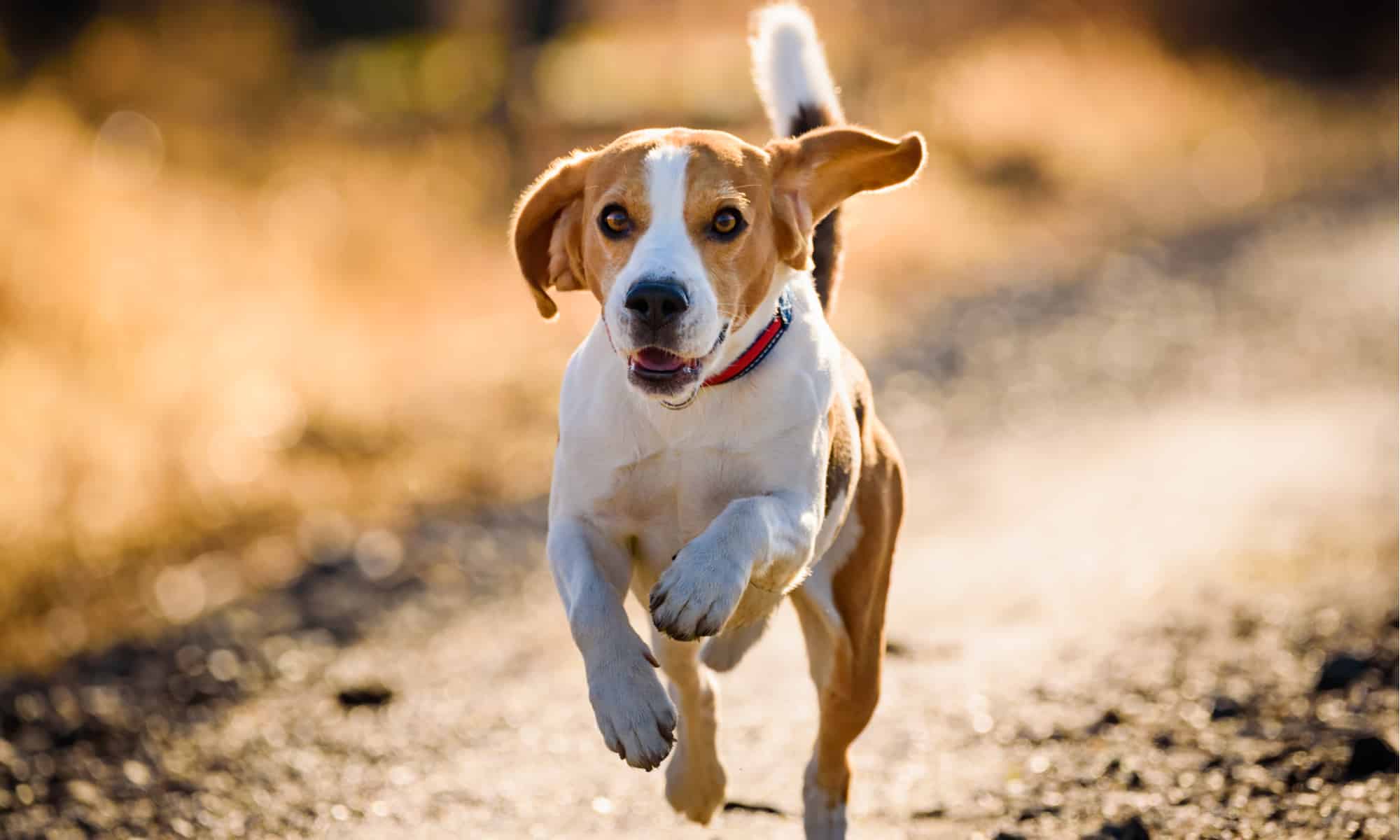From their name alone, it’s easy to determine that the dachshund is a dog bred in Germany. Their name translates to “badger dogs,” which is perfect because this breed was used for hunting badgers.
Dachshunds are energetic, loving, and intelligent. They are affectionally called sausage dogs, hotdogs, wiener dogs, and doxies.

Dachshunds were used for hunting badgers.
©Luiza Kleina/Shutterstock.com
Trained and bred to hunt, dachshunds weren’t always beloved household pets. They used to burrow deep into tunnels to hunt and kill badgers. There were two sizes of dachshunds: the standard size hunted badgers and wild boar, while the pint-sized dog was assigned hares and foxes. A middle-sized dachshund was also introduced in Germany.
Even though they are one of the most popular dogs in the world, not many people know the history of the dachshund.
Did you know that they had to be called another name during the first and second World Wars because of their connection to Germany? For a time, they were called “liberty hounds” and “badger dogs” to reduce their association with Germany.
Dachshund Traits
| Size | 9 to 32 pounds for males and females |
| Height | 5 to 9 inches |
| Lifespan | 12 to 16 years |
| Breed size | Small |
| Colors | Black, chocolate brown, gray, and tan |
| Exercise requirements | At least 30 to 40 minutes, daily |
| Energy level | Very energetic |
| Drool | Low |
| Snore | Low |
| Social skills | Highly sociable |
| Varieties | Smooth, wired, and long-coated |

A dappled dachshund with blue eyes.
©Michael E Hall/Shutterstock.com
Description And Size
There are three varieties of dachshunds—smooth-haired, wire-haired, and long-coated. The American Kennel Club recognizes all three types.
They all share the same elongated, hotdog-like body that stands low on two pairs of short and stubby legs. This body was meant to enter underground badger dens, which were narrow and small.
Despite their height, dachshunds are muscular with loose skin. This type of skin was honed perfectly for entering burrows. It won’t tear easily despite the tight spaces dachshunds might find themselves in.
Their tail was similarly built for survival and convenience. Its curve can easily be seen in terrains with long grass. The tail could also help humans to pull their dachshunds up and out when they get stuck in the burrow or the entrance of a tunnel.
This breed has a deep chest to accommodate the large lung capacity needed for hunting. The Dachshund has incredible stamina that works well for all the running it does. Its ears were also purposely made floppy, so dirt and grass would not enter them.

Dachshunds are wonderful dogs that were originally bred for hunting.
©Masarik/Shutterstock.com
Paws And Teeth
The dachshunds’ front paws are pretty big compared to the rest of their body. They are shaped like paddles, making them perfect for digging through soil. The paddle-like shape of their large front paws is also ideal when the dogs need to pull the prey out of the burrow or tunnel.
Their claws are also incredibly sharp. The same goes for their teeth because they needed their strong bite to immobilize their prey. At around 25 to 50 pounds, it’s hard to overpower a dachshund physically. They are sturdy and almost always ready to battle.
Coat
Hunting dogs like the dachshund developed coats perfect for the harsh climates and weather conditions of different environments they may have found themselves in. This breed has three coat types: short and smooth, long, and wiry.
The short and smooth coat may be the more recognizable coat variation for this breed, but the two other types help to protect the dogs from their environment. The wiry coat works for places with thorny briers, while the long coat is for cooler climates.
History
Although dachshunds are relatively free of such associations now, they had a sordid history from their connection to Germany. Europeans had been using this dog for hunting since the Middle Ages. However, it was only during the late 17th century in France and other European countries that these dogs began to get recognized as the breed we know today.
By the 18th century, German foresters and hunters started to breed dachshunds exclusively for hunting, which is where they got their name. “Dach” means badger, while “hund” means dog.
German Emperor Kaiser Wilhelm II, the last emperor, reportedly had a pair of dachshunds named Wadl and Hexl. Queen Victoria was also supposedly enamored by dachshunds after they were first introduced in the U.K. in 1840. The royal family brought the dogs there because of their hunting skills.
The dog became popular in the U.K. because of the Queen’s fondness for them. People began keeping them in their homes. Queen Elizabeth II, as much as she was fond of corgis, had a dorgi, after one of her corgis mated with a dachshund.

Dorgis love to interact with people, especially if it involves sports or games of some sort.
Bred to Hunt
Dachshunds were bred to hunt badgers, as their name implies. However, this breed can also track wounded game and chase after rabbits, foxes, and woodchucks. How did the dachshund hunt badgers? It was a simple process wherein hunters released the dog into the wild and they came back with a badger between their teeth.
Dachshunds accompanied the hunters when they went into the woods. The badgers would hide in the burrows, and the dachshunds would run after them. To hunt more effectively, these dogs would work in packs. They would enter the burrow from multiple entrances, giving the badgers no room to escape.
Their role was not to kill the badger. Instead, they needed to immobilize the badger and drag it out of the burrow to bring it to their humans. Badgers are not easy prey; They are agile and know their tunnels well. They also have thick fur that protects them from animal bites. Still, dachshunds were able to surround and hunt them successfully.
This breed also hunted woodchucks, foxes, raccoons, possums, squirrels, waterfowl, and other game. Since dachshunds come in two sizes, they used this to their advantage. The small variation would track woodchucks, while the larger dachshunds hunted badgers. For other game, the two variations of this breed worked together.
Tracking Wounded Game

A dachshund has a great sense of smell.
©Masarik/Shutterstock.com
Dachshunds don’t only hunt. They can also track the scent of wounded animals. Because of their short legs, these dogs stay close to the ground. This allows them to follow the scent line and track any injured game. Aside from following the scent line, these dogs are also great at differentiating the scents. They were not easily distracted by the smells from other animals – if the hunters wanted them to follow a deer’s scent, dachshunds could do it.
Dachshunds During the War
During World War I and II, dachshund owners called them “liberty hounds” to avoid any pro-German sentiments. They were not very popular during this time since the breed became a symbol of Germany to many.
This meant that dachshunds were sadly considered to be the enemies of the U.S. and the U.K. People began attacking and killing this breed in the streets. People who owned a dachshund had to face a stigma—they were labeled as German sympathizers; Some dachshund owners were even attacked.
Dachshunds in Modern Time
The AKC first recognized the dachshund in 1885. Since then, dachshund ownership has gained popularity in American households, and it is easy to see why.
Though they were initially bred for hunting, very few of them do that now. Instead, this breed makes for a wonderful companion dog. They are playful and love to be around their humans, including children.
Dachshunds aren’t as easily trainable as other dogs, like a Golden Retriever. They can be quite stubborn, so owners need patience when dealing with this breed’s temperament. It can be difficult to house-train a dachshund, so an obedience school can sometimes be beneficial. With enough time and commitment, dachshunds can become very well-trained.
Similar Animals to Dachshunds

Beagles were also bred to hunt.
©Przemek Iciak/Shutterstock.com
- Beagle: Like the dachshund, the beagle was bred to hunt. They are an affectionate, easygoing, and lovable dog that is great with kids. They used to hunt foxes and other game.
- Chihuahua: As one of the smallest breeds of dog, the chihuahua is a great apartment dog. They don’t need much exercise, and what little movement they need, they can get from inside the house. Their ancestors were bred mostly for religious rituals, food, and companionship.
- Basset Hound: This breed also has short legs and elongated bodies. They were originally bred for hunting hare. They have a strong sense of smell, which is perfect for following their prey.
Ready to discover the top 10 cutest dog breeds in the entire world?
How about the fastest dogs, the largest dogs and those that are -- quite frankly -- just the kindest dogs on the planet? Each day, AZ Animals sends out lists just like this to our thousands of email subscribers. And the best part? It's FREE. Join today by entering your email below.
Thank you for reading! Have some feedback for us? Contact the AZ Animals editorial team.








